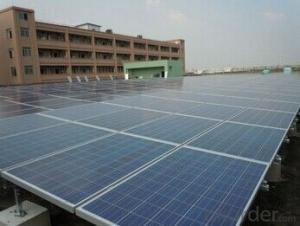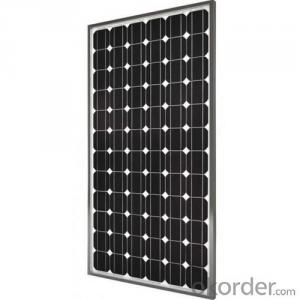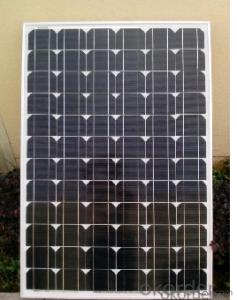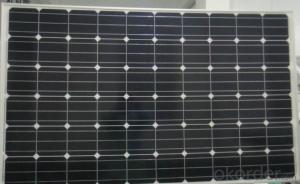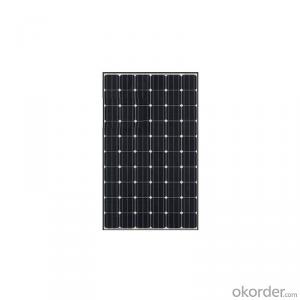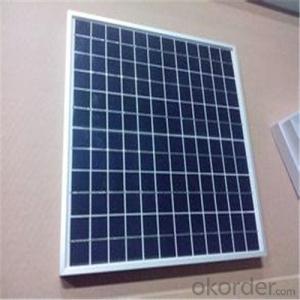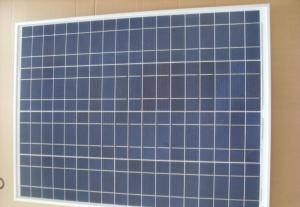75w-100w Mono Solar Panels, Solar System - Printable Solar Panels
- Loading Port:
- Shanghai
- Payment Terms:
- TT OR LC
- Min Order Qty:
- 200 pc
- Supply Capability:
- 99999 pc/month
OKorder Service Pledge
OKorder Financial Service
You Might Also Like
75W-100W Mono Solar Panels, Solar System
Specifications
1. 75-100W Mono crystalline solar
2. Super quality competitive price
3. solar system
Product Description
Material: Monocrystalline Silicon
Size: 1205*545*35mm
Number of Cells: 36
Max. Power: 75-100
Voc[V]: 21.8-22.6
Isc[A]: 4.85-6.03
Vmp[V]: 18.0-18.7
Imp[A]: 4.17-5.34
Module area [m]: 0.66
Module weight [kg]: 8
Features
High module conversion efficiency, through superior manufacturing technology Guaranteed -1% to +3% Power Tolerance Entire module certificated to withstand high wind loads and snow loads (5400Pa) Anodized aluminum is mainly for improving corrosion resistance.
Highly transparent, low-iron, tempered glass, and antireflective coating Excellent performance under low light environments
Benefits
25-year warranty on power output; 5-year warranty on materials and workmanship Product liability insurance
Local technical support
Local warehousing
48 hour-response service
Enhanced design for easy installation and long term reliability
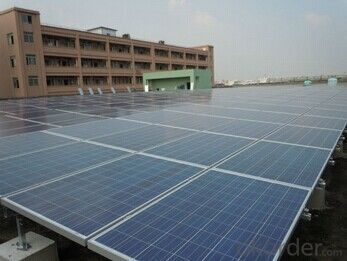
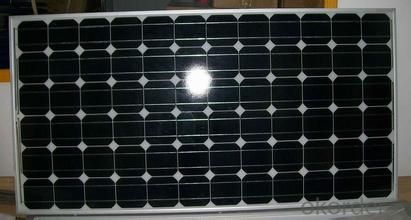
FAQ
Is solar power difficult to use?
Although the production of solar panels incorporates a high-tech manufacturing process, it is really very easy to use a photovoltaic system. Solar panels have no moving parts to wear out, they can be used alone or in combination with other energy sources, and they are silent, reliable and long lasting.
What can you power with Photovoltaics?
A properly designed photovoltaic system can supply electricity for many applications, from small remote lighting needs to megawatts of power for large utility companies. An advantage of photovoltaic power is that it can do anything a traditional power generator can do, only without consuming pollution-causing fuel, or requiring noisy motors.
What is a PV system?
A PV system consists of all the equipment and materials needed to generate solar energy, including solar panels (often called modules), a support structure, wiring, an inverter, a meter and other equipment as required by a specific application. JUST-SOLAR's PV system for commercial buildings, and ET Solar system for residential uses are examples of complete PV systems.
What is a solar module?
Solar modules are series of solar cells, wired together and enclosed protect them from the environment. They are often referred to as in self-contained glass units to solar panels as well.
How do solar cells work?
Solar cells are solid-state devices in which photons (or packets of light) collide with atoms. This process transforms the resulting into electrons. These electrons flow into wires connected to the cell, thus providing electric current to appliances, lighting systems or other electrical loads; and all of the power comes directly from the sun.
What is Photovoltaic Power?
Photovoltaic (PV) power is a term used to describe the process of converting sunlight into electricity with solar cells. These cells are specially constructed from semiconductor materials, and are treated to generate a flow of electricity when sunlight shines on them
- Q: Hello, I have been trying to go green, I Have purchase somesolar panel they are about 45watts I been putting it against my window and getting ok power out of it enough for my lights and a couple of low watts gadget (cellphone, 2v light, portable dvd) for couple of hours.But its seem to drain the 2v faster then I can charge Am I getting the most power out of my panel?Or should I place it on the roof? I'm in Texas and it gets hot and sunny the sun beam my room windows pretty good during 4pm-6pm.
- The MOST efficient placement is on a motorized mounting that constantly moves it to face the Sun directly. Almost nobody does that because it is clumsy and expensive. The best fixed position is facing X degrees due south of straight up, where X is your latitude. I am in Austin, at about 30 degrees latitude, so on the south side of a 30 degree pitched roof would be ideal. The direct south facing it the best average to catch morning and afternoon sun, with most efficient pointing at noon. The tilt equal to latitude is the best average between the high Sun in summer and low Sun in winter, with most efficient pointing in spring and fall.
- Q: I am researching several solar panels to install in my house. I would like to use a 40 watt panel to connect, through a solar battery controller, to a battery or two. I would then like to use the solar panel (40 watts) to charge the battery(ies) for emergency use. Once charged, and when needed, I would like to use the battery(ies), 2 volt deep cycle, to power several LED lamps. Since I am new to solar power I had several questions...Is a 40 watt panel strong/large enough to charge a 2 volt deep cycle battery or two?How long would it take to charge one of these batteries?What would be the expected cost to purchase necessary supplies? (With the solar panel, battery controller, and MC4 cabling I've found I have an expected cost of roughly $00.00 with batteries)Would this be difficult for someone with little experience in this field?
- Your demand is high. You require at least 5KVA (5000watts) out put with an appropriate battery storage and inverter..
- Q: Hello from SO TX.. I would like to know if anyone out there has SOLAR PANELS on their home?I have a 850 sq ft. house. I called Austin to a company that offers panels and installation. The cost $8,000.00, for 0 panels . The rep said we would save about 2 to 25% on our electric bill /mo. We use approximately 980 kw/mo. Our bill is around $40.00 / mo...I really don't think that's a good enough savings. We figure it would take 25 years to recoup our investment.And where we live in TX it does not offer any incentives. The gov. allows you a $2000.00 tx break.
- How Solar Cells Work by Scott Aldous Inside This Article . Introduction to How Solar Cells Work 2. Photovoltaic Cells: Converting Photons to Electrons 3. How Silicon Makes a Solar Cell 4. Anatomy of a Solar Cell 5. Energy Loss in a Solar Cell 6. Solar-powering a House 7. Solving Solar-power Issues 8. Solar-power Pros and Cons 9. Lots More Information 0. See all Physical Science articles You've probably seen calculators that have solar cells -- calculators that never need batteries, and in some cases don't even have an off button. As long as you have enough light, they seem to work forever. You may have seen larger solar panels -- on emergency road signs or call boxes, on buoys, even in parking lots to power lights. Although these larger panels aren't as common as solar powered calculators, they're out there, and not that hard to spot if you know where to look. There are solar cell arrays on satellites, where they are used to power the electrical systems. You have probably also been hearing about the solar revolution for the last 20 years -- the idea that one day we will all use free electricity from the sun. This is a seductive promise: On a bright, sunny day, the sun shines approximately ,000 watts of energy per square meter of the planet's surface, and if we could collect all of that energy we could easily power our homes and offices for free.
- Q: I have a small marine solar panel on my boat It came with the boat. I want to make sure it is working before I connect it. With a volt meter It is only reading .2 volts dc. I would think it should be 2-5 volts?
- Mark, the 2 vdc is pretty typical. Most panels for home use are set up to charge 2 volt batteries, and they are wired for an, open circuit voltage of 8 to 9 volts. This allows it to have enough voltage to feed through a few diodes, perhaps a charge controller and 30 or 40 feet of wire and still have at least 5 volts left over. Once you connect it to the battery the panel will drop to whatever the batteries charging curve voltage would be. If you have a few minutes, I would suggest getting a book at the library called, The Complete Battery Book, by Richard Perez. Just read the chapters pertaining to lead acid batteries, the other discussions on lithium, ni cads and such won't apply to your boat system. If your panel is not large, and it's short circuit current rating in amps is less than 2% of the amp hour capacity of the battery, you can even run the panel without a charge controller. The book explains this as well. There is a great magazine that gets into the nuts and bolts of this stuff, it's called Home Power, you can find it online. You might also find some info at a couple renewable energy websites, I will list them below. Panels are rated in two ways, open circuit voltage, which you measure with a multimeter while the panel is in open sun and nothing is connected to it. The other rating is short cirucuit current, which you measure with an ammeter while the panel is in the sun as well. You connect the ammeter across the output of the panel and let all the power short right through the meter, so you'll need an ammeter big enough to handle more amps than the panel puts out. A 0 amp unit will work for your boat panel. These tests won't hurt the panel, or the meters, we do it all the time in the field, and the manufacturers will tell you to do the same test if you have a problem with a panel and they want to know if it's malfunctioning. You can check one of their websites if you like. Good luck Mark, and take care, Rudydoo
- Q: On how to connect a solar panel to a battery and then to a lightbulb,the project is offgrid..
- Hi Igor, this is a very simplified version of the system I'm implementing in my shed. I used a guide found on an Answers! member's website, you may find what you're looking for there. Check out the sources section.
- Q: I don't have a regulator connected as they are a little expensive for a pensioner, If I join the panels into line to the battery bank from the roof should that be OK.?
- Two things on a regulator: a) It will optimize the charge to the batteries - and thereby distribute the most possible power to your active circuits during the day. b) It will prevent the power from the panels from boiling (no kidding) the batteries - no small thing as they are the second largest investment you have after the panels themselves. This is much more critical if you have sealed or Zero-Maintenance batteries. I strongly suggest that you get a regulator as it will significantly lengthen battery life. Follow the directions on the regulator for optimum input voltage and it will let you know whether all the panels should be in series, parallel or series/parallel. But cutting to the chase, you can certainly gang up panels as needed.
- Q: Has anyone actually used those kits online like energy4green or earth4energy to build their own solar panels or windmills? I'm so tempted but with my budget can't afford to waste any money. They have a 60 day money back policy but that doesn't include the money used to buy the supplies to try and build the things. My electric bill is almost $300 a month due to my stay at home disabled veteran husband who went from Utah snow to Florida sun and he has to have the AC on really cold. If anyone has actually built one can you tell me of your experience and if it actually is worth the money? I do lots of D.I.Y. projects but am a novice with electric besides installing a ceiling fan and changing out a light switch.
- Electric panels are not feasible for most people. They are two super thin layers of polarized material. When the sun hits them electrons move from the first to the second layer with an amount of force. You can't duplicate that at home. What you could do is setup solar heating panels and run them against a Stirling engine. This technique is typically more efficient than normal electric panels anyway in industry. They have heat on one side and cold on the other to generate force. Hook that to any generator to produce electricity. If you are successful building a home system, blog about it, others will want to know precisely how you did it.
- Q: Where can I find the info (sites) that clearly gives the anatomy of a solar panel?Likewise, I want to know where can I find (sites) the solar panel that produces 3.75 v? Thank you very much!!!
- You've probably seen calculators that have solar cells -- calculators that never need batteries, and in some cases don't even have an off button. As long as you have enough light, they seem to work forever. You may have seen larger solar panels -- on emergency road signs or call boxes, on buoys, even in parking lots to power lights. Although these larger panels aren't as common as solar powered calculators, they're out there, and not that hard to spot if you know where to look. There are solar cell arrays on satellites, where they are used to power the electrical systems. You have probably also been hearing about the solar revolution for the last 20 years -- the idea that one day we will all use free electricity from the sun. This is a seductive promise: On a bright, sunny day, the sun shines approximately ,000 watts of energy per square meter of the planet's surface, and if we could collect all of that energy we could easily power our homes and offices for free.
- Q: How long does it take a 5 watt, 2 volt solar panel to charge a 2 volt R.V. battery?
- depends on the sunlight. And on the size of the battery. But it may never charge, as you need at least 5 volts to charge a 2 volt battery. So unless the sunlight is bright enough to generate 5 volts, all you will do is discharge the battery through the solar panel. But a large battery is 00 amp hours of capacity. Even if you had a 5 volt 5 watt panel, that generates only amp at most, so it would take over 00 hours to charge that size battery. .
- Q: I have seen quite a few different websites that talk about building your own solar panels for around $200. I wanted to know if anyone has had any experience with this before I decide to try it myself. It would be very helpful to know what I can expect from such an inexpensive setup; what kind of electronics or appliances would I be able to power. Realistically what can I expect from a $200 setup, and what would I need to power say a whole bedroom (clock, regular sized TV, PC, ext.).
- Yes you can build a solar panel with that kind of money but i don't think you can do much with it. is more like a hobby or an experiment. If you want to see a custom made low cost solar panel check my blog.
Send your message to us
75w-100w Mono Solar Panels, Solar System - Printable Solar Panels
- Loading Port:
- Shanghai
- Payment Terms:
- TT OR LC
- Min Order Qty:
- 200 pc
- Supply Capability:
- 99999 pc/month
OKorder Service Pledge
OKorder Financial Service
Similar products
Hot products
Hot Searches
Related keywords
